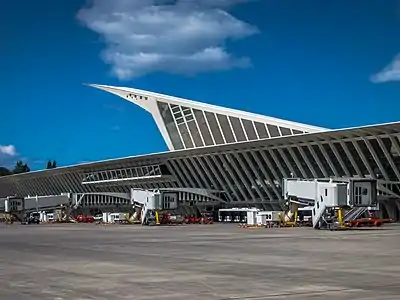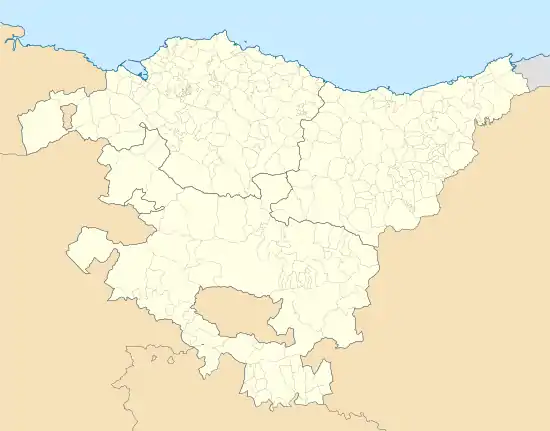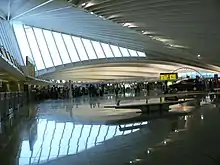Bilbao Airport | |||||||||||||||
|---|---|---|---|---|---|---|---|---|---|---|---|---|---|---|---|
 | |||||||||||||||
 | |||||||||||||||
| Summary | |||||||||||||||
| Airport type | Public | ||||||||||||||
| Owner/Operator | Aena | ||||||||||||||
| Location | Bilbao metropolitan area | ||||||||||||||
| Focus city for | |||||||||||||||
| Built | 1948 | ||||||||||||||
| Elevation AMSL | 42 m / 137 ft | ||||||||||||||
| Coordinates | 43°18′04″N 02°54′38″W / 43.30111°N 2.91056°W | ||||||||||||||
| Website | www | ||||||||||||||
| Map | |||||||||||||||
 BIO Location of the airport in the Basque Country | |||||||||||||||
| Runways | |||||||||||||||
| |||||||||||||||
| Statistics (2018) | |||||||||||||||
| |||||||||||||||
Bilbao Airport (IATA: BIO, ICAO: LEBB) is a minor international airport located 9 km (5.6 mi) north[4] of Bilbao, in the municipality of Loiu, in Biscay. It is the largest airport in the Basque Country and northern Spain, with 5,469,453 passengers in 2018. It is famous for its new main terminal opened in 2000 designed by Santiago Calatrava.
History
After various aeronautic experiments in the province of Biscay, in October 1927 steps were taken by the Union of Public Works to establish an airport in Bilbao. A Provincial Board was created to study the possible location of the airport. It was not until 1936 that the General Aeronautics Management authorised the installation of an airport in Sondika. However, due to the site's many deficiencies, the airport was not considered of interest. Bilbao is surrounded by mountains and a flat valley without significant population had to be found.
The construction works commenced during the Civil War but during this time and until June 1937 the airport was only used as a base for military activities. In 1938, the second stage of the airport's development began. The council resumed procedures with the government to modify the primitive project of 1936 and the drafting of a new project was authorised and later approved by the General Management of Infrastructure.
In 1940, it was decided by common agreement with the local organisations affected to build a civilian airport in Sondika. The construction works progressed slowly and on 19 September 1948, the airport was at last opened to daytime traffic with the establishment of an air path to Madrid by Aviación y Comercio, SA. Two years later, the terminal, named Carlos Haya after the well-known pilot from Bilbao, began to give service. At this time, the airport had an asphalt runway, the 11/29 (measuring 1,440 by 45 m (4,724 by 148 ft)), another earth runway (measuring 1,500 by 150 m (4,921 by 492 ft)), a taxiway, a passenger terminal, a tower control, a radio beacon, a direction finder as well as police, post office, weather, health, fuel and telephone services. In 1955, a taxiway was built to link the runway with the parking stands and terminal. An apron measuring 124 by 60 m (407 by 197 ft), a hangar for the Royal Flying Club of Vizcaya and permanent facilities for Campsa were also built.
Between 1964 and 1965, an instrumental ILS landing system and a meteorological radio for storm detection were installed; the runway was extended to 2,000 m (6,562 ft) and the apron to 12,000 m2 (130,000 sq ft). In 1975, the runway was surfaced and its orientation became 10/28 due to the change in magnetic declination. In 1977, the parking stand was extended, a link road was built and an ILS system was installed. The runway 12/30, measuring 2,600 m (8,530 ft) long, was opened the same year and the airport was classified as first category the following year. As a result of the population density of the area, approaching planes may have to fly over the extensive Derio cemetery.
During the 1980s, the ILS landing system entered into service for runway 10/28; the communication centre, passenger terminal and parking facilities were enlarged; and a fire service building and cargo terminal were constructed.
On 19 February 1985, an Iberia flight from Madrid crashed into Mount Oiz, all passengers and crew died.[5]
In 1996, a new taxiway with two rapid exits and a new aircraft parking apron were built. The works required the removal of tons of soil poisoned with lindane residues. In May 1999, the new tower control was put into service, which allowed for a more centred vision of the airfield and at the same time facilitated airport operations. On 19 November 2000, a new terminal area was opened in the north zone, consisting of a new terminal building, with a surface area of 32,000 m2 (340,000 sq ft), a car park with 3,000 parking spaces measuring 95,000 m2 (1,020,000 sq ft) and a north apron for aircraft parking to serve the new terminal area.
In February 2009, plans were announced to expand the terminal building, the facilities and the car parking so as to double the current capacity to 8 million passengers. The work was expected be finished in 2014 and cost €114 million but in 2010 the Spanish Government announced the project would be delayed by at least 5 years due to spending cuts and a decline in passenger numbers.[6]
Design of the passenger terminal
The terminal has a sleek design, with two symmetrical "wings" and a sharp tip at its center which is especially visible when approaching the terminal from the sides. This original design has granted the building the nickname of La Paloma ("The Dove").[7] White concrete and glass have been used. The interiors are open and luminous spaces, distributed in two floors, the upper one for departures (check-in counters and gates) and the lower for arrivals.
There has been some criticism of Santiago Calatrava's design by Aena, the Spanish airport authority, because it seems difficult to make further enlargements in the terminal's capacity because the design is too closed. In spite of this, modifications took place in 2005–2006 in the check-in area to provide enhanced shopping facilities for travellers, which almost doubled the retail space now being offered.
Users of the airport widely complained about its lack of an arrivals area, since once passengers cleared customs, they stepped directly outside, and there they were often exposed to the elements. The airport built a glass-walled shelter to remedy this problem.[7]
Traffic
The airport has seen a constant increase in its traffic numbers, the old terminal was already saturated and obsolete in 1990, although it had been renewed only a few years earlier. At the present day Bilbao is the most important hub in northern Spain and the number of passengers using the new terminal continues to rise, especially after the increased tourist interest in the city since the opening of the Guggenheim Museum Bilbao.
With the past increase of traffic, the terminal would have become saturated again in a year because it is designed to handle about 4.5 million passengers per year, in 2007 it went nearly to its maximum capacity. However, the global financial crisis of 2008 has reversed the situation as of early 2009, decreasing the number of passengers by 24% in January compared to previous year. In 2014 traffic is on the rise again and saw the recovery of passengers up to 5.4 million passengers by 2018.[8]
Airlines and destinations
The following airlines operate regular scheduled and charter flights at Bilbao Airport:
Statistics


.jpg.webp)
| Passengers | Change from previous year | Aircraft movements | Change from previous year | Cargo (tonnes) | Change from previous year | |
|---|---|---|---|---|---|---|
| 2000 | 2,556,373 | 45,506 | 4,038 | |||
| 2001 | 2,491,770 | 44,166 | 3,674 | |||
| 2002 | 2,463,698 | 39,832 | 3,699 | |||
| 2003 | 2,850,524 | 44,009 | 3,813 | |||
| 2004 | 3.395,773 | 50,361 | 4,152 | |||
| 2005 | 3,843,953 | 56,285 | 3,956 | |||
| 2006 | 3,876,072 | 58,574 | 3,417 | |||
| 2007 | 4,286,751 | 63,076 | 3,230 | |||
| 2008 | 4,172,903 | 61,682 | 3,178 | |||
| 2009 | 3,654,957 | 54,148 | 2,691 | |||
| 2010 | 3,888,969 | 54,119 | 2,547 | |||
| 2011 | 4,045,613 | 54,432 | 2,633 | |||
| 2012 | 4,171,092 | 50,030 | 2,663 | |||
| 2013 | 3,800,789 | 42,683 | 2,536 | |||
| 2014 | 4,015,352 | 42,590 | 2,855 | |||
| 2015 | 4,277,430 | 43,862 | 2,872 | |||
| 2016 | 4,588,265 | 45,105 | 2,974 | |||
| 2017 | 4,973,712 | 46,989 | 1,956 | |||
| 2018 | 5,469,453 | 49,966 | 1,216 | |||
| Source: Aena Statistics[1] | ||||||
Top Carriers
| Rank | Carrier | Passengers 2021 | % | Passenger % Change 2020 | Passenger % Change 2019 |
|---|---|---|---|---|---|
| 1 | 1,351,077 | 52.35 | |||
| 2 | 259,469 | 10.05 | |||
| 3 | 238,769 | 9.25 | |||
| 4 | 211,203 | 8.18 | |||
| 5 | 187,969 | 7.28 | |||
| 6 | 80,009 | 3.10 | |||
| 7 | 55,831 | 2.16 | |||
| 8 | 43,708 | 1.69 | |||
| 9 | 23,864 | 0.92 | |||
| 10 | 22,051 | 0.85 | |||
| Source: Aena Statistics[1] | |||||
Busiest routes
| Rank | City | Passengers 2021 | % | Passenger % Change 2020 |
Passenger % Change 2019 |
|---|---|---|---|---|---|
| 1 | 355,298 | 13.77 | |||
| 2 | 322,573 | 12.50 | |||
| 3 | 206,138 | 7.99 | |||
| 4 | 186,896 | 7.24 | |||
| 5 | 177,670 | 6.88 | |||
| 6 | 132,362 | 5.13 | |||
| 7 | 111,182 | 4.31 | |||
| 8 | 107,488 | 4.16 | |||
| 9 | 100,876 | 3.91 | |||
| 10 | 96,642 | 3.74 | |||
| Source: Aena Statistics[1] | |||||
Public transport
Bus
- BizkaiBus: a bus line (A3247) connects Bilbao center (Moyúa square) and the city bus station with the airport. Buses depart every 15 to 20 minutes.[28]
- BizkaiBus: a bus line (A2153) connects Bilbao center (San Jose square) with Larrabetzu stopping at the airport. Buses depart every hour.[29]
- A bus operated by PESA to Donostia-San Sebastián; its only stop is at Zarautz - adjacent to one of the town's two Euskotren stations (at the eastern end of the town). Buses depart every hour.
- A bus operated by PESA to Mondragón with stops in Eibar and Bergara; the last daily service continues until Oñati. There are 6 buses departing from Bergara every day, and a single bus from Oñati.
- Starting in 2024, a bus line will connect Vitoria-Gasteiz city center with Bilbao airport, buses will depart every 2 hours, stopping at Vitoria bus station, Vitoria Airport and Bolueta neighborhood in Bilbao.[30]
Metro extension
There is a project to extend Metro Bilbao's Line 3 to the airport in the near future, but there is no official timetable yet.
Accidents and incidents
- On 15 September 1975 British Airways flight NS552 operated by Trident 1E G-AVYD was written off at Bilbao while taking off. The aircraft came off the runway following the commander's decision to abort the take-off on a wet runway at or close to V1.[31]
- On 19 February 1985, Iberia Flight IB610 from Madrid crashed into Mount Oiz. All 148 passengers and crew on board were killed.
- On 7 February 2001, Iberia Airlines Flight 1456 arriving from Barcelona encountered wind shear while landing and suffered collapsed landing gear. All people on board survived but 25 people were injured.[32]
See also
References
- 1 2 3 4 AENA passenger statistics and aircraft movements
- ↑ Spanish AIP (AENA) Archived 13 January 2017 at the Wayback Machine
- ↑ "Bilbao".
- ↑ EAD Basic
- ↑ The Associated Press (20 February 1985). "48 Are Killed As Spanish Jet Hits Mountain". The New York Times.
- ↑ García, Josu (19 November 2010). "La ampliación del aeropuerto de Bilbao se retrasa al menos 5 años". El Correo (in Spanish). Vocento. Retrieved 17 September 2019.
- 1 2 Daley, Suzanne (13 September 2013). "A Star Architect Leaves Some Clients Fuming". The New York Times. Retrieved 13 September 2013.
- ↑ "'La Paloma' pierde un 24% de pasajeros en el primer mes de un año "difícil"". Archived from the original on 1 August 2009. Retrieved 20 February 2009.
- ↑ "Flight schedule Tangier to Bilbao". airarabia.com. Retrieved 1 March 2021.
- ↑ "AIR CAIRO NS23 NETWORK ADDITIONS – 13OCT22". aeroroutes.com. 14 October 2022.
- ↑ "Air Cairo Adjusts Spain Service in NW22".
- ↑ "Azores Airlines Adds Bilbao Service in 3Q23".
- ↑ "Bilbao".
- ↑ "Eurowings flies to more destinations in summer 2022 than ever before".
- ↑ "Iberia expands seasonal Funchal service in 3Q23". aeroroutes. 29 November 2022.
- ↑ "Norwegian NS24 Network Additions – 14NOV23". AeroRoutes.
- ↑ "Smartwings Adds Bilbao – Ilha Do Sal Charters in NS24". AeroRoutes.
- ↑ "Bilbao has more passengers in June than any other month to date; gained nine airlines since 2020". 24 July 2023.
- ↑ volotea.com - Destinations retrieved 17 June 2022
- ↑ "VOLOTEA - Vuelos baratos, ofertas y billetes de avión a Europa". 24 December 2023.
- ↑ "Volotea Announces New Base in Bari, Italy". 14 December 2023.
- 1 2 "Volotea unirá este verano Loiu con la ciudad portuguesa de Faro y Santorini". 30 November 2022.
- ↑ "E' base Volotea a Firenze". 3 November 2022.
- ↑ https://www.preferente.com/noticias-de-transportes/noticias-de-aerolineas/volotea-lanza-una-nueva-ruta-entre-bilbao-y-marruecos-322041.html
- ↑ "Volotea, è Olbia la più grande base italiana nel 2023. Scalza Venezia". 26 January 2023.
- ↑ "Vienna: Wizz Air starts Bilbao and Kuwait City". 14 December 2022.
- ↑ "Wizz Air launches new routes from Warsaw to Valencia and Bilbao". 8 August 2022.
- ↑ Moovit, A3247: Aireportua/Aeropuerto (Etorrerak/Llegadas) (1003)→Bilbao Intermodal (2877), accessed 18 March 2021
- ↑ Bizkaiko Foru Aldundia, LINEAREN XEHETASUNAK: A2153 - BILBAO - TXORIERRI - LARRABETZU, accessed 3 May 2023
- ↑ Gasteiz Hoy Hasta 13 autobuses diarios desde el centro de Vitoria al aeropuerto de Bilbao , accessed 3 May 2023
- ↑ "Accident description in the Aviation Safety Network". Archived from the original on 24 May 2005.
- ↑ "Accident description on the Aviation Safety Network website". Archived from the original on 10 March 2005.
External links
![]() Media related to Bilbao Airport at Wikimedia Commons
Media related to Bilbao Airport at Wikimedia Commons
- Official website
 (in English and Spanish)
(in English and Spanish)